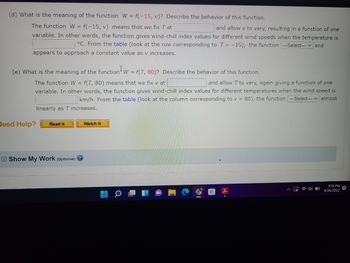
Calculus: Early Transcendentals
8th Edition
ISBN: 9781285741550
Author: James Stewart
Publisher: Cengage Learning
expand_more
expand_more
format_list_bulleted
Question

Transcribed Image Text:(d) What is the meaning of the function W = f(-15, v)? Describe the behavior of this function.
The function W = f(-15, v) means that we fix T at
and allow v to vary, resulting in a function of one
variable. In other words, the function gives wind-chill index values for different wind speeds when the temperature is
°C. From the table (look at the row corresponding to T = -15), the function ---Select--- and
appears to approach a constant value as v increases.
(e) What is the meaning of the function W = f(T, 80)? Describe the behavior of this function.
The function W = f(T, 80) means that we fix v at
and allow T to vary, again giving a function of one
variable. In other words, the function gives wind-chill index values for different temperatures when the wind speed is
km/h. From the table (look at the column corresponding to v = 80), the function ---Select--- ✓ almost
linearly as T increases.
Need Help?
Read It
Show My Work (optional) →
Watch It
9:16 PM
9/26/2022

Transcribed Image Text:In this example we considered the function W = f(T, v), where W is the wind-chill index, T is the actual temperature, and v is the wind
speed. A numerical representation is given in this table.
(a) What is the value of f(-20, 40)? What is its meaning?
f(-20, 40) =
, which means that if the temperature is -20°C and the wind speed is 40 km/h, then
the air would feel equivalent to approximately
°C without wind.
(b) Describe in words the meaning of the question "For what value of v is f(-10, v) = -15?"
The question is asking: when the temperature is
°C?
Answer the question.
V =
km/h
Answer the question.
T =
(c) Describe in words the meaning of the question "For what value of T is f(T, 10) = -39?"
The question is asking: when the wind speed is
°C?
°C
°C, what wind speed gives a wind-chill index of
E
km/h, what temperature gives a wind-chill index of
d
9:16 PM
9/26/2022
Expert Solution
arrow_forward
Step 1
Solution:
Wind-chill index = W = f(T,v) = 13.12 + 0.6215T - 11.37(v0.16) + 0.3965T(v0.16) ,
T - Temperature in degree Celsius
v - Wind velocity in kilometers per hour
Step by stepSolved in 3 steps with 3 images

Knowledge Booster
Similar questions
- Consider the function y =-4* –11 +21. -4* -11 +21, the base function y = 4* must be axis and it is translated 1. To achieve the function y %3D reflected in the i ii units upward. The statement above is best completed by the answers in row: Row i ii У-аxis 21 Х-аxis 21 у-аxis 11 х-аxis 11arrow_forwardThe cost, C (in dollars) to produce g gallons of ice cream can be expressed as C = f(g). (a) In the expression f(250) = 350, what are the units of 250?? what are the units of 350?? (b) In the expression ƒ'(250) = 1.4, what are the units of 250?? what are the units of 1.4? ? (Be sure that you can carefully put into words the meanings of each of these statement in terms of ice cream and money.)arrow_forwardGiven the following table, find each value. xf(x) -6-10 10 5 -2 8 -9 7 8 10 -6 (a) f (7) = (b) ƒ(10) = (c) f( – 6) = (d) ƒ -'(8) : 7.arrow_forward
arrow_back_ios
arrow_forward_ios
Recommended textbooks for you
 Calculus: Early TranscendentalsCalculusISBN:9781285741550Author:James StewartPublisher:Cengage Learning
Calculus: Early TranscendentalsCalculusISBN:9781285741550Author:James StewartPublisher:Cengage Learning Thomas' Calculus (14th Edition)CalculusISBN:9780134438986Author:Joel R. Hass, Christopher E. Heil, Maurice D. WeirPublisher:PEARSON
Thomas' Calculus (14th Edition)CalculusISBN:9780134438986Author:Joel R. Hass, Christopher E. Heil, Maurice D. WeirPublisher:PEARSON Calculus: Early Transcendentals (3rd Edition)CalculusISBN:9780134763644Author:William L. Briggs, Lyle Cochran, Bernard Gillett, Eric SchulzPublisher:PEARSON
Calculus: Early Transcendentals (3rd Edition)CalculusISBN:9780134763644Author:William L. Briggs, Lyle Cochran, Bernard Gillett, Eric SchulzPublisher:PEARSON Calculus: Early TranscendentalsCalculusISBN:9781319050740Author:Jon Rogawski, Colin Adams, Robert FranzosaPublisher:W. H. Freeman
Calculus: Early TranscendentalsCalculusISBN:9781319050740Author:Jon Rogawski, Colin Adams, Robert FranzosaPublisher:W. H. Freeman
 Calculus: Early Transcendental FunctionsCalculusISBN:9781337552516Author:Ron Larson, Bruce H. EdwardsPublisher:Cengage Learning
Calculus: Early Transcendental FunctionsCalculusISBN:9781337552516Author:Ron Larson, Bruce H. EdwardsPublisher:Cengage Learning

Calculus: Early Transcendentals
Calculus
ISBN:9781285741550
Author:James Stewart
Publisher:Cengage Learning

Thomas' Calculus (14th Edition)
Calculus
ISBN:9780134438986
Author:Joel R. Hass, Christopher E. Heil, Maurice D. Weir
Publisher:PEARSON

Calculus: Early Transcendentals (3rd Edition)
Calculus
ISBN:9780134763644
Author:William L. Briggs, Lyle Cochran, Bernard Gillett, Eric Schulz
Publisher:PEARSON

Calculus: Early Transcendentals
Calculus
ISBN:9781319050740
Author:Jon Rogawski, Colin Adams, Robert Franzosa
Publisher:W. H. Freeman


Calculus: Early Transcendental Functions
Calculus
ISBN:9781337552516
Author:Ron Larson, Bruce H. Edwards
Publisher:Cengage Learning